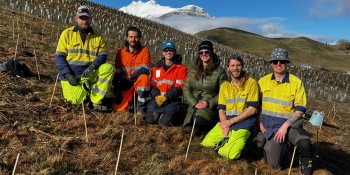QLDC forecasts 27,000 new houses - no answers on infrastructure cost

Analysis.
In a bewildering final council meeting before Saturday’s local elections, councillors agreed to send an official development forecast to central Government that calls for 27,000 new houses - in spite of a declared lack of infrastructure.
The forecast, over a year late, is something required from all NZ councils so that Government can factor different levels of growth into their policy decisions. It’s part of the Government’s National Policy Statement on Urban Development that designates the QLDC’s territory as a high growth zone.
Deputy Mayor Quentin Smith, speaking for most of the councillors present, confessed to having multiple questions about the way the forecast was produced and the assumptions made about infrastructure and how it was to be funded.
“We’ve known about this problem for years. There’s an absolutely staggering level of infrastructure deficit. There is a crisis in infrastructure – especially Queenstown’s Southern Corridor and Hāwea.
“How do we improve infrastructure when we have no available investment?”
“Roads are excluded from this process ….. How can we ignore transport?” asked the Deputy Mayor.
Council staff who tabled the document said that ignoring transport was a “requirement of the process.”

-
Matt Wong asked: “How does this document help us moderate growth?”
In answering questions about how the required infrastructure was going to be paid for there was a lot of discussion around development contributions - from property developers. But staff and councillors agreed that it was hard, if not impossible, to quantify how, or even if, property developers would cover the cost of future infrastructure. So far that has not worked - and ratepayers have been left to pick up the tab.
The 207 page document, link below, defied three attempts by Crux to read it and fully understand it. In the end we asked Google’s Pinpoint tool to summarise the contents.
Here’s the output:
“The Queenstown Lakes District (QLD) is planning for a significant increase in new houses. The urban environment housing bottom lines, with competitiveness margins applied, project the need for:
-
Short-Medium Term (10 years, 2023-2033): an additional 9,100 dwellings.
-
Long Term (20 years, 2033-2053): an additional 18,000 dwellings.
-
Combined Total Long Term (30 years, 2023-2053): an additional 27,100 dwellings.
These figures are based on the High Plus QLDC projections, which anticipate dwelling demand to nearly double over the next 30 years, reaching 48,100 dwellings in total. Nearly all of this growth (a net increase of 22,800 dwellings) is expected to occur within the urban environment.
The planned capacity for housing development within the district’s urban environment is substantial:
-
Short-term: There is plan enabled capacity for a net additional 50,200 dwellings.
-
Medium-term: The plan enabled capacity increases by 54% to 77,100 net additional dwellings, largely due to proposed changes to the Proposed District Plan (PDP).
-
Long-term: Further capacity is signaled through the Spatial Plan, adding sizeable areas of urban expansion, increasing the plan enabled capacity by 20% (from the medium-term) to 92,200 net additional dwellings.
However, the amount of capacity that is “reasonably expected to be realised” (RER), which accounts for infrastructure readiness and commercial feasibility, is lower:
-
Short-term: Total RER capacity is 1,700 net additional dwellings.
-
Medium-term: RER capacity increases to 15,100 net additional dwellings.
-
Long-term: RER capacity reaches 29,700 net additional dwellings.
Source: Google Pinpoint summary of the 207 Page Queenstown Lakes District Housing and Business Development Capacity Assessment 2025
Here’s how Pinpoint summarised the document’s answer to the question: “How can all these houses get built without sufficient infrastructure?”
“The provided text does not contain a direct answer to the question “How can all these houses get built without sufficient infrastructure?” It discusses the impact of infrastructure on housing capacity and notes that infrastructure constraints can limit the additional supply of new dwellings. However, it does not explain how houses can be built without sufficient infrastructure.”
Source: Google Pinpoint summary of the 207 Page Queenstown Lakes District Housing and Business Development Capacity Assessment 2025
So that’s a bit alarming.
All the councillors could do today was agree to workshop the document when the new council is formed. The forecast is not exactly a contract but councils are expected to stick to what they predict. And now the document is on its way to Wellington - apparently without any proper debate or illumination of the modelling processes used.

-
It was Esther Whitehead’s last council meeting as she is not standing for re-election. “I’m sad to leave but won’t miss the conflict and the tension.”
The document is a glaring example of extremely important things that get approved often without councillors having the time to understand or research the document - let alone debate the contents.
Here’s the full document.

























